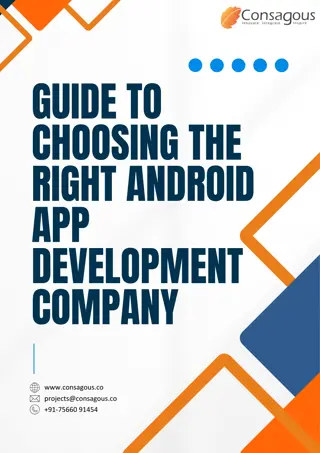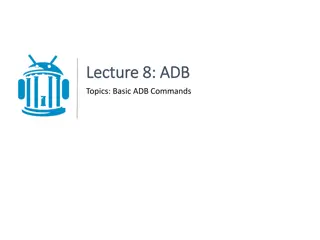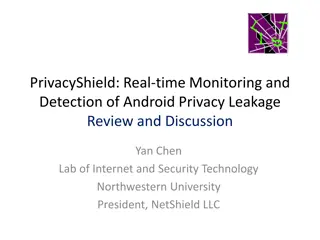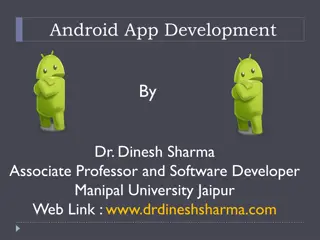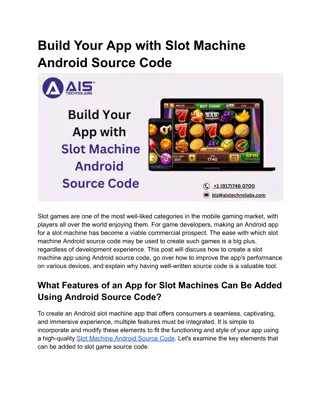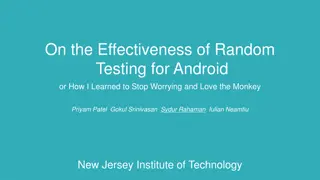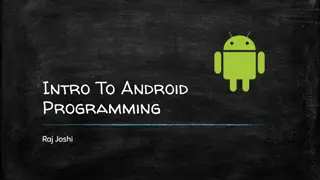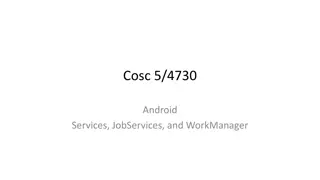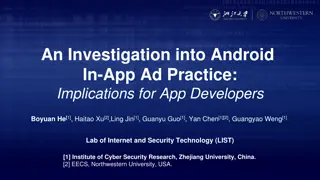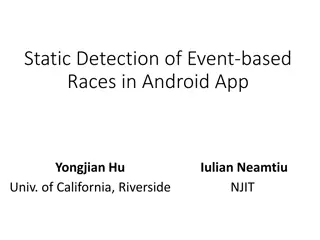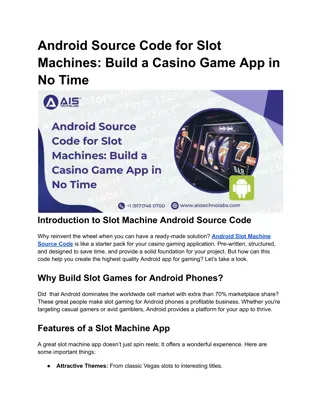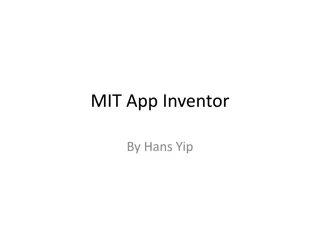
Android App Development Essentials
Explore the fundamentals of Android app development including components, logging, activities, and more. This comprehensive guide covers key concepts for building efficient and robust mobile applications.
Download Presentation

Please find below an Image/Link to download the presentation.
The content on the website is provided AS IS for your information and personal use only. It may not be sold, licensed, or shared on other websites without obtaining consent from the author. If you encounter any issues during the download, it is possible that the publisher has removed the file from their server.
You are allowed to download the files provided on this website for personal or commercial use, subject to the condition that they are used lawfully. All files are the property of their respective owners.
The content on the website is provided AS IS for your information and personal use only. It may not be sold, licensed, or shared on other websites without obtaining consent from the author.
E N D
Presentation Transcript
1 Native Mobile Applications - ICD0017 TalTech IT College, Andres K ver, 2019-2020, Spring semester Web: http://enos.Itcollege.ee/~akaver/mobileapps Skype: akaver Email: akaver@itcollege.ee
Android app components 2 Logging Activity Intent Fragment Service ContentProvider BroadcastReceiver
Android - logging 3 Full support in ide Use android.util.Log Verbose Log.v(), debug Log.d(), info Log.i(), warn Log.w(), error Log.e(), or what a terrible Failure Log.wtf() Deployed application should not contain logging code Use BuildConfig.DEBUG flag for checking state (deployed or not) if (BuildConfig.DEBUG) { Log.e(Constants.TAG, "onCreate called"); } TAG string, usually statically fixed public class FragmentMain extends Fragment { private static final String TAG = FragmentMain.class.getSimpleName(); public static int w (String tag, Throwable tr) public static int w (String tag, String msg, Throwable tr)
Android - activity 4 Activity one screen (UI and code) User interface 1..n activities Every activity is separate component Activity can start other activities Back stack (lifo) Has to be declared in manifest also!
Android - activity 5 Activity FragmentActivity ListActivity PreferenceActivity TabActivity
Android - activity 6 One activity is designated as Main Launched on first app activation Every time new activity is started, previous one is stopped Previous activity is stored in the back stack When activity is stopped/paused, callback methods are called Callbacks create, resume, stop, destroy, etc
Android new activity 7 Create subclass of Activity (or subclass of subclass of Activity) Implement callbacks OnCreate() OnPause() Implement user interface XML layout file Or programmatically
Android new activity, manifest 8 <manifest ... > <application ... > <activity android:name=".ExampleActivity" /> ... </application ... > ... </manifest > Declaration in AndroidManifest is mandatory Specify intent filters Intent filter declares, how other system components may use this activity Auto-created stub for main activity Action action.MAIN activity responds to the main action Category category.LAUNCHER actitvity is placed into launcher category <activity android:name=".ExampleActivity" android:icon="@drawable/app_icon"> <intent-filter> <action android:name="android.intent.action.MAIN" /> <category android:name="android.intent.category.LAUNCHER" /> </intent-filter> </activity>
Android new activity, starting 9 startActivity(intent) Starting your own activity specify class name Intent intent = new Intent(this, SignInActivity.class); startActivity(intent); Calling other activities Intent intent = new Intent(Intent.ACTION_SEND); intent.putExtra(Intent.EXTRA_EMAIL, recipientArray); startActivity(intent); Intent.EXTRA_EMAIL stores list of email recipients
Android new activity, starting for result 10 StartActivityForResult() Implement onActivityResult() callback method private void pickContact() { // Create an intent to "pick" a contact, as defined by the content provider URI Intent intent = new Intent(Intent.ACTION_PICK, Contacts.CONTENT_URI); startActivityForResult(intent, PICK_CONTACT_REQUEST); } @Override protected void onActivityResult(int requestCode, int resultCode, Intent data) { // If the request went well (OK) and the request was PICK_CONTACT_REQUEST if (resultCode == Activity.RESULT_OK && requestCode == PICK_CONTACT_REQUEST) { // Perform a query to the contact's content provider for the contact's name Cursor cursor = getContentResolver().query(data.getData(), new String[] {Contacts.DISPLAY_NAME}, null, null, null); if (cursor.moveToFirst()) { // True if the cursor is not empty int columnIndex = cursor.getColumnIndex(Contacts.DISPLAY_NAME); String name = cursor.getString(columnIndex); // Do something with the selected contact's name... } } }
Android shut down activity 11 Finish() shut down previously started activity finishActivity()
Android activity lifecycle 12 Three essential states Resumed In foreground, has user focus. running Paused Activity is partially visible, and is alive . Can be killed by system in low memory situation Stopped Activity is 100% obscured by another activity. It is alive, but is not attached to the window manager. Can be killed by system, when memory is needed. Paused or Stopped system calls finish() method on activity. When activity is reopened, it must be created again
Android Lifecycle callbacks 13 public class ExampleActivity extends Activity { @Override public void onCreate(Bundle savedInstanceState) { super.onCreate(savedInstanceState); // The activity is being created. } @Override protected void onStart() { super.onStart(); // The activity is about to become visible. } @Override protected void onResume() { super.onResume(); // The activity has become visible (it is now "resumed"). } @Override protected void onPause() { super.onPause(); // Another activity is taking focus (this activity is about to be "paused"). } @Override protected void onStop() { super.onStop(); // The activity is no longer visible (it is now "stopped") } @Override protected void onDestroy() { super.onDestroy(); // The activity is about to be destroyed. } } Fundamental callbacks Must always call the superclass implementation before doing any work
Android Lifecycle 14
Android - SaveInstanceState 15 system calls onSaveInstanceState() before making the activity vulnerable to destruction Passes Bundle, as name-value pairs Save state, using putString() and putInt() Bundle is passed back in onCreate() and onRestoreInstanceState()
Android - handling conf changes 16 Orientation change, physical keyboard, language System recreates the running activity calls onDestroy(), then immediately calls onCreate()
Android Intent and Intent filters 17 Messaging object, used for requesting action from another app component Fundamental uses Start an activity startActivity or startActivityForResult Start a service startService or bindService Deliver broadcast sendBroadcast, sendOrderedBroadcast, or sendStickyBroadcast
Android Intent and Intent filters 18 Explicit intents Specify component by name (usually in your own app) Implicit intents Declare general action to perform System searches in manifests (intent-filter) for suitable activity If several are found, user is presented with dialog for picking
Android - intents 19 // Executed in an Activity, so 'this' is the Context // The fileUrl is a string URL, such as "http://www.example.com/image.png" Intent downloadIntent = new Intent(this, DownloadService.class); downloadIntent.setData(Uri.parse(fileUrl)); startService(downloadIntent); Explicit intent Implicit intent // Create the text message with a string Intent sendIntent = new Intent(); sendIntent.setAction(Intent.ACTION_SEND); sendIntent.putExtra(Intent.EXTRA_TEXT, textMessage); sendIntent.setType("text/plain"); Forcing an app chooser To show the chooser, create an Intent using createChooser() and pass it to startActivity() // Verify that the intent will resolve to an activity if (sendIntent.resolveActivity(getPackageManager()) != null) { startActivity(sendIntent); } Intent sendIntent = new Intent(Intent.ACTION_SEND); ... // Always use string resources for UI text. // This says something like "Share this photo with" String title = getResources().getString(R.string.chooser_title); // Create intent to show the chooser dialog Intent chooser = Intent.createChooser(sendIntent, title); // Verify the original intent will resolve to at least one activity if (sendIntent.resolveActivity(getPackageManager()) != null) { startActivity(chooser); }
Android intent filter 20 To advertise which implicit intents your app can receive declare one or more intent filters for each of your app components with an <intent-filter> element in your manifest file Action intent action accepted, in the name attribute Data type of data accepted, using one or more attributes that specify various aspects of the data URI (scheme, host, port, path, etc.) and MIME type Category category accepted, in the name attribute. In order to receive implicit intents, you must include the CATEGORY_DEFAULT
Android intent filter 21 Activity declaration with an intent filter to receive an ACTION_SEND intent when the data type is text <activity android:name="ShareActivity"> <intent-filter> <action android:name="android.intent.action.SEND"/> <category android:name="android.intent.category.DEFAULT"/> <data android:mimeType="text/plain"/> </intent-filter> </activity> An implicit intent is tested against a filter by comparing the intent to each of the three elements. To be delivered to the component, the intent must pass all three tests.
Android intent filter 22 Social app <activity android:name="MainActivity"> <!-- This activity is the main entry, should appear in app launcher --> <intent-filter> <action android:name="android.intent.action.MAIN" /> <category android:name="android.intent.category.LAUNCHER" /> </intent-filter> </activity> <activity android:name="ShareActivity"> <!-- This activity handles "SEND" actions with text data --> <intent-filter> <action android:name="android.intent.action.SEND"/> <category android:name="android.intent.category.DEFAULT"/> <data android:mimeType="text/plain"/> </intent-filter> <!-- This activity also handles "SEND" and "SEND_MULTIPLE" with media data --> <intent-filter> <action android:name="android.intent.action.SEND"/> <action android:name="android.intent.action.SEND_MULTIPLE"/> <category android:name="android.intent.category.DEFAULT"/> <data android:mimeType="application/vnd.google.panorama360+jpg"/> <data android:mimeType="image/*"/> <data android:mimeType="video/*"/> </intent-filter> </activity>
Android receive intent - code 23 void onCreate (Bundle savedInstanceState) { ... // Get intent, action and MIME type Intent intent = getIntent(); String action = intent.getAction(); String type = intent.getType(); if (Intent.ACTION_SEND.equals(action) && type != null) { if ("text/plain".equals(type)) { handleSendText(intent); // Handle text being sent } else if (type.startsWith("image/")) { handleSendImage(intent); // Handle single image being sent } } else if (Intent.ACTION_SEND_MULTIPLE.equals(action) && type != null) { if (type.startsWith("image/")) { handleSendMultipleImages(intent); // Handle multiple images being sent } } else { // Handle other intents, such as being started from the home screen } ... void handleSendText(Intent intent) { String sharedText = intent.getStringExtra(Intent.EXTRA_TEXT); if (sharedText != null) { // Update UI to reflect text being shared } } } void handleSendImage(Intent intent) { Uri imageUri = (Uri) intent.getParcelableExtra(Intent.EXTRA_STREAM); if (imageUri != null) { // Update UI to reflect image being shared } } void handleSendMultipleImages(Intent intent) { ArrayList<Uri> imageUris = intent.getParcelableArrayListExtra(Intent.EXTRA_STREAM); if (imageUris != null) { // Update UI to reflect multiple images being shared } }
Android - Fragments 24 A panel or pane represents a part of the user interface. A fragment is an independent Android component which can be used by an activity. A fragment runs in the context of an activity, but has its own life cycle and typically its own user interface. No Context class, use the getActivity()
Android - Fragments 25 Extend the android.app.Fragment class or one of its subclasses, for example, ListFragment, DialogFragment, PreferenceFragment or WebViewFragment public class DetailFragment extends Fragment { @Override public View onCreateView(LayoutInflater inflater, ViewGroup container, Bundle savedInstanceState) { View view = inflater.inflate(R.layout.fragment_rssitem_detail, container, false); return view; } public void setText(String url) { TextView view = (TextView) getView().findViewById(R.id.detailsText); view.setText(url); } }
Android Fragments communication 26 Should not directly communicate with each other Should be done via the host activity Define an interface as an inner type Require that the activity, which uses it, must implement this interface
Android - Fragments 27 public class MyListFragment extends Fragment { @Override public void onAttach(Context context) { super.onAttach(context); if (context instanceof OnItemSelectedListener) { listener = (OnItemSelectedListener) context; } else { throw new ClassCastException(context.toString() + " must implemenet " + "MyListFragment.OnItemSelectedListener"); } } private OnItemSelectedListener listener; @Override public View onCreateView(LayoutInflater inflater, ViewGroup container, Bundle savedInstanceState) { View view = inflater.inflate(R.layout.fragment_rsslist_overview, container, false); Button button = (Button) view.findViewById(R.id.button1); button.setOnClickListener(new View.OnClickListener() { @Override public void onClick(View v) { updateDetail("fake"); } }); return view; } @Override public void onDetach() { super.onDetach(); listener = null; } public interface OnItemSelectedListener { public void onRssItemSelected(String link); } // may also be triggered from the Activity public void updateDetail(String uri) { // create a string just for testing String newTime = String.valueOf(System.currentTimeMillis()); // inform the Activity about the change based // interface defintion listener.onRssItemSelected(newTime); } }
Android fragments lifecycle 28 fragment has its own life cycle always connected to the life cycle of the activity activity stops, its fragments are stopped activity is destroyed, its fragments are also destroyed.
Android defining fragments 29 Adding fragments statically to the layout file Different static layout files for different device configurations Can be done dynamically <?xml version="1.0" encoding="utf-8"?> <LinearLayout xmlns:android="http://schemas.android.com/apk/res/android" android:layout_width="fill_parent" android:layout_height="fill_parent" android:baselineAligned="false" android:orientation="horizontal"> <fragment android:id="@+id/listFragment" class="com.example.android.rssreader.MyListFragment" android:layout_width="0dp" android:layout_height="match_parent" android:layout_weight="1"></fragment> <fragment android:id="@+id/detailFragment" class="com.example.android.rssreader.DetailFragment" android:layout_width="0dp" android:layout_height="match_parent" android:layout_weight="2"></fragment> </LinearLayout>
Android fragments demo 30 Its demo time (FragmentDemo01)! After hours demo - use different number of fragments depending on the portrait/landscape configuration
Android - Service 31 Runs in the background without direct interaction with the user Not bound to the lifecycle of an activity Used for repetitive and potentially long running operations Internet downloads checking for new data Streaming Service runs in the same process as the main thread of the app Use asynchronous processing in the service
Android Service (platform) 32 Predefined system services Application can use them, given the right permissions getSystemService()
Android Service (custom) 33 <service android:name="MyService" android:icon="@drawable/icon" android:label="@string/service_name"></service> Declare in manifest import android.app.Service; import android.content.Intent; import android.os.IBinder; Inside <application> tags! /** * Created by akaver on 07.11.2015. */ public class MyService extends Service { Extend the Service class or one of its subclasses. @Override public int onStartCommand(Intent intent, int flags, int startId) { //TODO do something useful return Service.START_NOT_STICKY; } Start service Can also start via bindService(). Allows direct communication with the service @Override public IBinder onBind(Intent intent) { //TODO for communication return IBinder implementation return null; } Use android:exported="false for keeping service private } // use this to start and trigger a service Intent i= new Intent(this, MyService.class); // potentially add data to the intent i.putExtra("KEY1", "Value to be used by the service"); this.startService(i);
Android service restart 34 Service.START_STICKY Service is restarted if it gets terminated. Intent data passed to the onStartCommand method is null. Used for services which manages their own state and do not depend on the Intent data. Service.START_NOT_STICKY Service is not restarted. Used for services which are periodically triggered anyway. Service.START_REDELIVER_INTENT Similar to Service.START_STICKY but the original Intent is re-delivered to the onStartCommand method.
Android service stop 35 stopService() One call to the stopService() method stops the service. stopSelf() service terminates itself. Used when service finishes its work.
Android communication with service 36 Simple scenario no direct communication. Service receives intent when starting. Using receiver Service broadcasts events Activity registers broadcast receiver and receives events from service Activity binds to local service IBinder, onBind()
Android service 37 Service starting, stopping and starting a new thread in service ServiceDemo02 Binder demo ServiceDemo01

